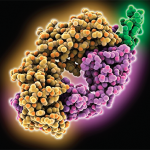 Rituximab binds to the CD20 antigen and mediates B cell depletion, actions that led to its indication for the treatment of non-Hodgkin’s lymphoma, lymphocytic leukemia, rheumatoid arthritis and granulomatosis with polyangiitis (GPA). However, clinical trials in adults have not supported its use as a treatment for systemic lupus erythematosus (SLE). A new systematic review, published online June 8 in the Journal of Pediatrics, concludes that rituximab may be a safe and effective treatment for pediatric SLE (pSLE).1
Rituximab binds to the CD20 antigen and mediates B cell depletion, actions that led to its indication for the treatment of non-Hodgkin’s lymphoma, lymphocytic leukemia, rheumatoid arthritis and granulomatosis with polyangiitis (GPA). However, clinical trials in adults have not supported its use as a treatment for systemic lupus erythematosus (SLE). A new systematic review, published online June 8 in the Journal of Pediatrics, concludes that rituximab may be a safe and effective treatment for pediatric SLE (pSLE).1
Ines Mahmoud, PhD, a researcher at Mar University in Tunisia, and colleagues conducted a systematic search of clinical trials and observational studies that yielded 549 citations. Twelve case series (three multicenter and three prospective) met the authors’ criteria for data extraction according to an 18-criteria checklist using a modified Delphi method. None of the studies included a control group. In total, the case series included 272 patients with active disease who were refractory to steroids and immunosuppressant drugs. The studies were predominantly British, American and Canadian (60% of patients), and refractory lupus nephritis was the most common indication (33%) for rituximab therapy. However, children were also treated for other disease manifestations, including cytopenia, vasculitis, arthritis, serositis, neuropsychiatric disease, skin disorders, pulmonary hypertension, ophthalmic disorders and general symptoms.
The studies point to a conclusion that rituximab is safe and effective as a treatment for renal and hematologic manifestations of pSLE. Treated patients experienced significant improvement in renal function and reduction in proteinuria within two to 12 months. Additionally, the children who received rituximab as a treatment for refractory autoimmune cytopenia achieved complete remission. Three studies also reported statistically significant, short-term (one to eight months) improvements in disease activity.
In their review, the authors note that one of the main goals in the treatment of SLE is the prevention of relapse. When they looked through the literature for that particular outcome, they found that only three studies reported relapses and from these studies they calculated a relapse rate that ranged from 9–30% following treatment with rituximab, with a median time to relapse of two to 22 months.
The authors found that rituximab seemed to have a steroid-sparing effect in pediatric patients. Patients also showed improvements in neuropsychiatric manifestations, disease activity, complement and anti-double stranded Deoxy-Nucelo-Adenosine. In particular, C3 values increased in eight studies and C4 values increased in six studies. The two studies that evaluated neuropsychiatric manifestations both reported significant clinical improvement for this endpoint. In contrast, however, there was poor evidence to suggest efficacy for arthralgia, photosensitivity and mucocutaneous manifestations of SLE in children.


